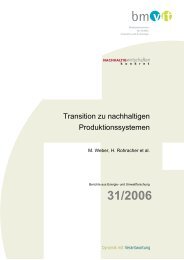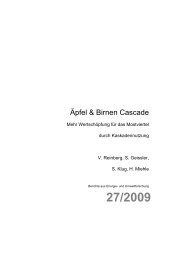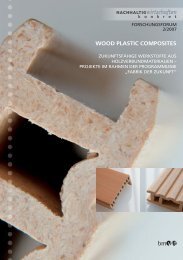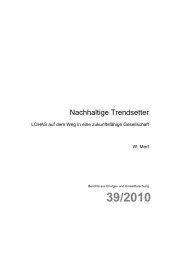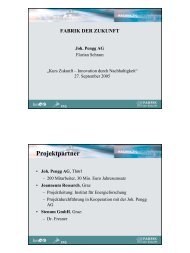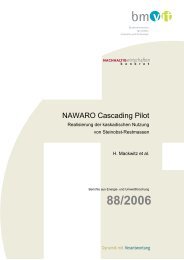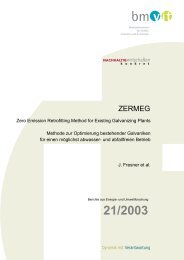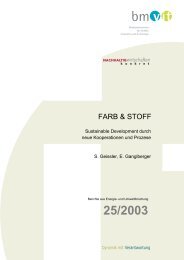ZERMEG II – Zero emission retrofitting method ... - Fabrik der Zukunft
ZERMEG II – Zero emission retrofitting method ... - Fabrik der Zukunft
ZERMEG II – Zero emission retrofitting method ... - Fabrik der Zukunft
Erfolgreiche ePaper selbst erstellen
Machen Sie aus Ihren PDF Publikationen ein blätterbares Flipbook mit unserer einzigartigen Google optimierten e-Paper Software.
At the wire producer the rinsing technology was changed by the following measures:<br />
� combination of a two stage rinsing cascade with a static tank to a three stage rinsing<br />
cascade<br />
� separation of the rinses in the continuous pickling plants into three stage rinsing<br />
cascades<br />
The volume of rinsing water in the static pickling could be reduced by 50 % until now.<br />
Parallel to these studies a theoretical approach could be developed over the last months to<br />
use the spent acids in another company.<br />
In the printed circuit board manufacturer two options were implemented:<br />
� an electrolysis plant to recover copper from etching concentrates and rinsing water<br />
� use of caustic stripping solutions as pre-neutralisation of acid concentrates<br />
This company could acquire a practically new used electrolysis plant. The feasibility study<br />
showed that the plant definitely should be installed. Because of the capacity the electrolysis<br />
plant however was not installed at the location which participated in the project, but in a<br />
sister plant. There now 20 kg of copper daily are recycled from the waste water. In the<br />
waste water treatment plant now caustic concentrates are used after filtration to neutralise<br />
acidic concentrates. This saves annually 20 tons of caustic soda and a similar volume of<br />
hydrochloric acid.<br />
In the hot dip zincing plant a consequent separated management of pickling tanks was<br />
introduced by separating the de-zincing and the pickling completely. Now they are recycled<br />
completely by two other companies. The topping up of the pickling baths is done on the<br />
basis of weekly bath analyses and the consequent application of the mixing rules. By this the<br />
acid consumption for the year 2004 could be reduced by 50 % compared to 2003.<br />
In the anodising company the direct evaporation of the rinsing water would be a good<br />
opportunity to install a complete rinsing water cycle. In the distillate no organic compounds<br />
were found and the contents in salts is very low. This process should be implemented, if<br />
there was enough space for a third stage in the two rinsing cascades.<br />
At the printing cylin<strong>der</strong> manufacturer the galvanising machines were equipped with new flat<br />
nozzles with an optimised geometry and the water pressure was minimized. Thus the water<br />
consumption was reduced by 50 % and the acid consumption by 40 %.<br />
The following fields of action for future work could be identified:<br />
� simple, easy to use and cheap analysis <strong>method</strong>s<br />
� collection of real experience with the operation of existing plants to enlarge the<br />
useful life of galvanic baths<br />
� testing and further developing combinations of processes to enlarge the useful life of<br />
galvanic plants (combinations of pre-cleaning and membranes, pre-cleaning and ion<br />
exchangers) to take care of impurities in the practical processes (organic materials,<br />
process chemicals and metals)<br />
� programming of corresponding models to supplement the calculation routines<br />
� focused analysis of the potential to use the spent process baths externally and<br />
analyse the possibilities to create the infrastructure to collect the materials and<br />
realize the potential actually<br />
Early in 2004 the intermediate results of <strong>ZERMEG</strong> <strong>II</strong> were presented during a workshop of<br />
the Factory of the Future. During this event the results and the potential for co-operation<br />
with other projects of the programme were discussed intensively.<br />
<strong>ZERMEG</strong> - Ein Projekt <strong>der</strong> <strong>Fabrik</strong> <strong>der</strong> <strong>Zukunft</strong> geför<strong>der</strong>t von BMVIT und FFF<br />
Endbericht <strong>ZERMEG</strong> <strong>II</strong><br />
Seite 19




